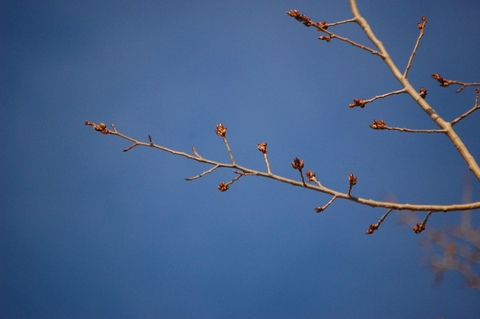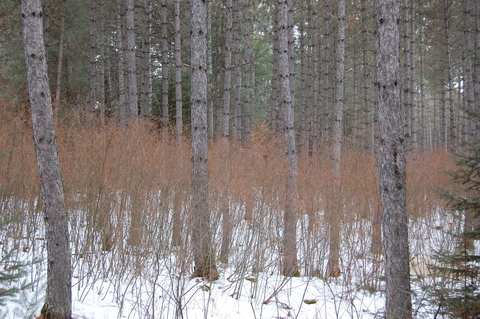To attract wildlife, most landowners do one of three things: Plant trees, dig a pond or create food plots. These may or may not be the most effective strategies. Why?
Remember the four basic needs of wildlife: Food, water, cover and space. Think about your landscape, including your neighbors’ properties and beyond. What’s missing that your target species need? Let those needs guide your planning.
If you want to attract specific wildlife species to your property, your best information source is a wildlife professional in your area. Start by calling your local Minnesota Department of Natural Resources (DNR) wildlife office; they can help you plan and implement your wildlife conservation strategies.
Strategies for improving woodland wildlife habitat
Plant (or retain) patches of dense conifers
Pockets of balsam fir, spruce or other shade-tolerant conifers provide much-needed cover for deer and other species, helping them stay warm in cold weather.
Create and maintain openings in dense forest stands
Openings often include different species than the surrounding forest, including important food species. But openings also increase edge habitat. This may or may not be desirable, depending on your target species.
Mix aspen of different ages
Maintaining aspen of various ages in close proximity is particularly effective for ruffed grouse and white-tailed deer. Young, dense aspen stands provide cover from predators as well as nutritious food (buds) within reach of deer. Older aspen is an excellent food source for grouse.
Plant trees in open areas
If you live in an area with more open field than forest, consider establishing trees on the landscape. Trees provide mast (food) as well as cover and shade for wildlife.
Protect riparian corridors
Forested areas along waterways provide unique habitat for wildlife. Trees along the water provide shade, cover and (in some cases) unique food sources for wildlife.
You can harvest timber in riparian corridors, but it’s important to maintain some intact vegetation along stream and river banks.
Feeding stations and food plots
In some cases, feeding stations and planted food plots can be a good idea. But they can also be problematic. There’s evidence that feeding stations can concentrate wildlife and spread disease.
Creating winter habitat for pheasants
When spring weather melts the snow and landscapes become green, it’s easy to forget to make appropriate winter habitat to help pheasants survive the next winter.
Planning ahead for resident wildlife will make sure you design suitable winter habitat where it’s needed most.
Grassland-dependent species, like pheasants, thrive in farmlands with a mixture of cultivated grains, undisturbed grasslands and wetlands. They need undisturbed grass habitats for nesting, brood rearing, roosting and escape cover.
Most pheasants move less than 2 miles between summer and winter range. So, you need a core winter complex within 2 miles of grasslands. Consider herbaceous or woody cover plantings if no winter cover is within 2 miles of grassland habitat.
If a core wintering complex is within 2 miles of your area, concentrate on improving the quality of your grassland habitats for nesting and brooding birds (increase plants, such as cattails and clover, to increase accessibility and insect availability for chicks).
If your land is within a half mile of a windbreak that meets these needs but lacks lodging-resistant herbaceous cover (like cattails) or food, then concentrate on providing those needs. These will complement the existing woody cover area.
Remember, without a reliable food source, even the best winter cover can’t support wildlife in a severe winter. A reliable food source is edible, digestible, available in all types of weather, year after year, and in adequate amounts to last all winter (November to March).
Food plots or leaving crops in the field have been most practical. You can use feeders (inaccessible to deer) in conjunction with food plots. Crops for pheasant food plots (from most to least beneficial) include corn, grain sorghum, sunflower, soybeans, wheat, oats and millet.
The primary functions of an effective winter cover:
- Protect from blowing and drifting snow.
- Reduce wind chill exposure.
- Provide escape cover from predators.
Types of cover
There are two types of cover:
- Herbaceous cover: A large block that’s at least 10 acres. This could be cattails, native grasses, sorghum-sudan grass or narrow-row corn.
- Woody cover: A well-designed woody cover planting for wildlife that’s at least 3 acres. This could be a farmstead shelterbelt (windbreak), and should include conifers and shrubs.
Planting winter cover
A minimum woody planting would include:
- Two shrub rows on the windward side to catch drifting snow.
- Four or more rows of conifers.
- One or two rows of shrubs on the leeward side, or the side sheltered from the wind.
The distance from the outermost row to the innermost row should be 200 feet. Shrubs are important to include in the design because they offer shelter as well as food.
The ideal cover is at least a 15-acre block comprised of a 3- to 5-acre shrub and conifer/evergreen planting. This planting should be north and/or west of an adjacent block of heavy herbaceous cover and a 2- to 4-acre corn food plot.
Note: Do not plant woody cover plantings in areas you’re managing for native species that depend on large, uninterrupted grasslands (e.g., prairie chicken, upland sandpiper) or species that are vulnerable to cowbird parasitism (e.g., bobolink, dickcissel).
Opportunities exist for cost share and even annual land payments for land planted to trees as windbreaks, wildlife plantings, shelterbelts and living snow fence establishment.
For example, the U.S. Department of Agriculture Conservation Reserve Program’s continuous sign-up period offers many positive grassland, wetland and tree planting incentives. Contact your county Farm Service Agency (FSA), Natural Resources Conservation Service (NRCS), Soil and Water Conservation District, Minnesota Department of Natural Resources (DNR) or University of Minnesota Extension office for more details.
DNR and local conservation organizations, including Pheasants Forever chapters, may also have cost-share assistance programs for establishing food plots.
The table below lists native shrubs, unless noted otherwise (some non-native species may not be eligible for State funding programs).
Table: Recommended shrubs for winter pheasant habitat
| Name | Scientific name | Characteristics | Height | Width |
|---|---|---|---|---|
| Arrowwood, Downy | Viburnum rafinesquianum | 6 feet (ft) | 6 ft | |
| Black Chokeberry | Aronia melanocarpa | Can spread; suckers | 10 ft | 6-8 ft |
| Buffaloberry, Silver | Shepherdia argentea | For sandy soils | 8 ft | 10 ft |
| Cranberry, Highbush | Viburnum trilobum | 10 ft | 12 ft | |
| Cranberry, American | Opulus var. Americanum | 10 ft | 12 ft | |
| Dogwood | Cornus sericea | Redosier | 10 ft | 12 ft |
| Dogwood | Cornus racemosa | Gray | 10 ft | 10 ft |
| Dogwood | Cornus amomum | Silky | 10 ft | 10 ft |
| Elderberry, Black | Sambucus nigra | 20 ft | 10 ft | |
| False Indigo | Amorpha sp. | Dwarf, desert, many cultivars | 10 ft | 10 ft |
| Hazelnut, American | Corylus americana | 8-10 ft | 6-8 ft | |
| Lilac (non-native) | Syringa vulgaris | Suckers; provides cover; no food value for wildlife | 15 ft | 12 ft |
| Nannyberry | Viburnum lentago | 20-25 ft | 6-10 ft | |
| Ninebark | Physocarpus opulifolius | 10 ft | 10 ft | |
| Sandbar Willow | Salix interior | Suckers | 5-10 ft | 5-10 ft |
| Sand Cherry | Prunus cistena | 8 ft | 8 ft | |
| Serviceberry | Amelanchier alnifolia | Eight Minnesota native species | 10-30 ft | 10-20 ft |
| Silverberry | Elaeagnus commutata | Suckers | 5-9 ft | 3-6 ft |
The table below lists native small trees, unless noted otherwise (some non-native species may not be eligible for State funding programs).
Table: Recommended small trees for winter pheasant habitat
| Name | Scientific name | Characteristics | Height | Width |
|---|---|---|---|---|
| American Plum | Prunus americana | Can spread; suckers | 20 feet (ft) | 15-25 ft |
| Chokeberry | Prunus virginiana | Can spread; suckers | 20 ft | 15-35 ft |
| Crabapple (non-native) | Malus sp. | Apple scab resistant and susceptible varieties | 20-30 ft | 20-30 ft |
| Hawthorn* | Crataegus sp. | 10 Minnesota native species | 15-20 ft | 15-20 ft |
| Pin Cherry | Prunus pensylvanica | 15 ft | 15-20 ft |
*Note: Apple and hawthorn trees shouldn’t be planted near red cedar trees due to disease problems (cedar-apple rust). Plant spacing requirements depend on species and desired density. Red cedar can be aggressive and needs to be managed.
White spruce and white cedar are native. Varieties like Black Hills and Techny (white cedar) aren’t native, but are excellent for Southwestern Minnesota.
Table: Recommended conifers for winter pheasant habitat
| Name | Scientific name | Characteristics | Height | Width |
|---|---|---|---|---|
| Eastern Red Cedar* | Juniperus virginiana | Use native species; can be aggressive | 50 feet (ft) | 10-15 ft |
| Eastern White Pine** | Pinus strobus | 100 ft | 50-80 ft | |
| Northern White Cedar | Thuja occidentalis | Protect from deer | 50 ft | 10-20 ft |
| White Spruce (Black Hills; non-native) | Picea glauca (densata variety) | 50 ft | 20-30 ft | |
| White Spruce** | Picea glauca (moench) voss | 100 ft | 20-30 ft |
*Note: Apple and hawthorn trees shouldn’t be planted near red cedar trees due to disease problems (cedar-apple rust). Plant spacing requirements depend on species and desired density. Red cedar can be aggressive and needs to be managed. White spruce and white cedar are native. Varieties like Black Hills and Techny (white cedar) aren’t native, but are excellent for Southwestern Minnesota.
**Large conifers that are tall and sparsely branched (white pine, white spruce) may not be recommended for your eco-region or landscape. Always consider native plants first. But there are also approved non-native varieties that may add superior habitat for specific sites. Review your habitat plans with local specialists.
Reviewed in 2019




